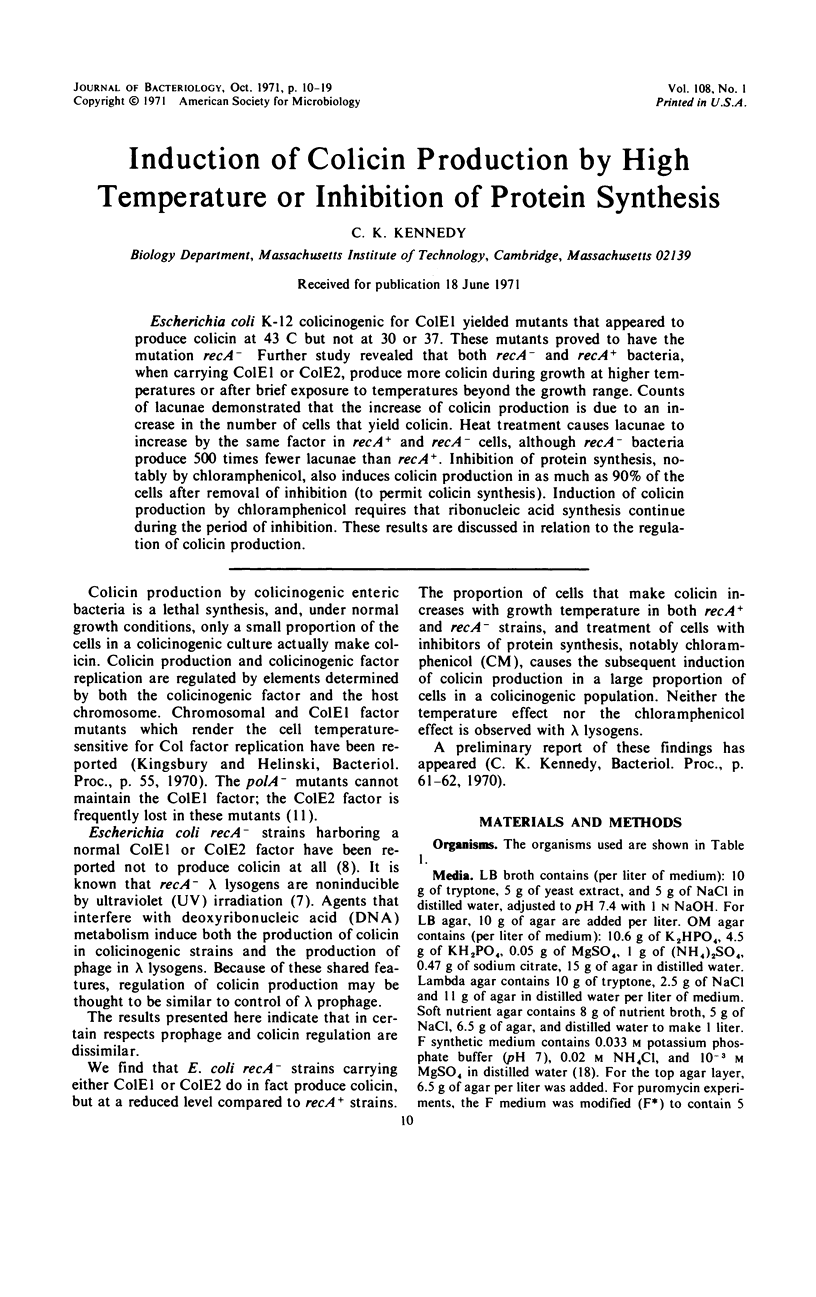Abstract
Escherichia coli K-12 colicinogenic for ColE1 yielded mutants that appeared to produce colicin at 43 C but not at 30 or 37. These mutants proved to have the mutation recA− Further study revealed that both recA− and recA+ bacteria, when carrying ColE1 or ColE2, produce more colicin during growth at higher temperatures or after brief exposure to temperatures beyond the growth range. Counts of lacunae demonstrated that the increase of colicin production is due to an increase in the number of cells that yield colicin. Heat treatment causes lacunae to increase by the same factor in recA+ and recA− cells, although recA− bacteria produce 500 times fewer lacunae than recA+. Inhibition of protein synthesis, notably by chloramphenicol, also induces colicin production in as much as 90% of the cells after removal of inhibition (to permit colicin synthesis). Induction of colicin production by chloramphenicol requires that ribonucleic acid synthesis continue during the period of inhibition. These results are discussed in relation to the regulation of colicin production.
Full text
PDF









Selected References
These references are in PubMed. This may not be the complete list of references from this article.
- AMATI P. VEGETATIVE MULTIPLICATION OF COLICINOGENIC FACTORS AFTER INDUCTION IN ESCHERICHIA COLI. J Mol Biol. 1964 Feb;8:239–246. doi: 10.1016/s0022-2836(64)80133-9. [DOI] [PubMed] [Google Scholar]
- Bazaral M., Helinski D. R. Replication of a bacterial plasmid and an episome in Escherichia coli. Biochemistry. 1970 Jan 20;9(2):399–406. doi: 10.1021/bi00804a029. [DOI] [PubMed] [Google Scholar]
- Ben-Gurion R. Chloramphenicol and puromycin as inducers of colicinogenic bacteria. Biochem Biophys Res Commun. 1970 Sep 30;40(6):1281–1288. doi: 10.1016/0006-291x(70)90005-7. [DOI] [PubMed] [Google Scholar]
- Edlin G., Broda P. Physiology and genetics of the "ribonucleic acid control" locus in escherichia coli. Bacteriol Rev. 1968 Sep;32(3):206–226. doi: 10.1128/br.32.3.206-226.1968. [DOI] [PMC free article] [PubMed] [Google Scholar]
- Epstein W. Transposition of the lac region of Escherichia coli. IV. Escape from repression in bacteriophage-carried lac genes. J Mol Biol. 1967 Dec 28;30(3):529–543. doi: 10.1016/0022-2836(67)90366-x. [DOI] [PubMed] [Google Scholar]
- Fuerst C. R., Siminovitch L. Characterization of an unusual defective lysogenic strain of Escherichia coli K-12(lambda). Virology. 1965 Nov;27(3):449–451. doi: 10.1016/0042-6822(65)90131-5. [DOI] [PubMed] [Google Scholar]
- Helinski D. R., Herschman H. R. Effect of Rec mutations on the activity of colicinogenic factors. J Bacteriol. 1967 Sep;94(3):700–706. doi: 10.1128/jb.94.3.700-706.1967. [DOI] [PMC free article] [PubMed] [Google Scholar]
- JACOB F., SIMINOVITCH L., WOLLMAN E. L. Comparison entre la biosynthèse induite de la colicine et des bactériophages et entre leur mode d'action. Ann Inst Pasteur (Paris) 1953 Jan;84(1):313–318. [PubMed] [Google Scholar]
- KURLAND C. G., MAALOE O. Regulation of ribosomal and transfer RNA synthesis. J Mol Biol. 1962 Mar;4:193–210. doi: 10.1016/s0022-2836(62)80051-5. [DOI] [PubMed] [Google Scholar]
- Kingsbury D. T., Helinski D. R. DNA polymerase as a requirement for the maintenance of the bacterial plasmid colicinogenic factor E1. Biochem Biophys Res Commun. 1970 Dec 24;41(6):1538–1544. doi: 10.1016/0006-291x(70)90562-0. [DOI] [PubMed] [Google Scholar]
- LUZZATI D., CHEVALLIER M. R. INDUCTION, PAR CARENCE EN THYMINE, DE LA PRODUCTION DE COLICINE PAR DES BACT'ERIES COLICINOG'ENES THYMINE-EXIGEANTES. Ann Inst Pasteur (Paris) 1964 Nov;107:SUPPL–SUPPL:162. [PubMed] [Google Scholar]
- NAGELDEZWAIG R., PUIG J. THE GENETIC BEHAVIOUR OF COLICINOGENIC FACTOR E. J Gen Microbiol. 1964 Aug;36:311–321. doi: 10.1099/00221287-36-2-311. [DOI] [PubMed] [Google Scholar]
- NATHANS D. PUROMYCIN INHIBITION OF PROTEIN SYNTHESIS: INCORPORATION OF PUROMYCIN INTO PEPTIDE CHAINS. Proc Natl Acad Sci U S A. 1964 Apr;51:585–592. doi: 10.1073/pnas.51.4.585. [DOI] [PMC free article] [PubMed] [Google Scholar]
- OZEKI H., STOCKER B. A., DE MARGERIE H. Production of colicine by single bacteria. Nature. 1959 Aug 1;184:337–339. doi: 10.1038/184337a0. [DOI] [PubMed] [Google Scholar]
- Rosenkranz H. S., Carr H. S. Studies with hydroxyurea. II. Prolonged exposure of Escherichia coli to hydroxyurea. J Bacteriol. 1966 Jul;92(1):178–185. doi: 10.1128/jb.92.1.178-185.1966. [DOI] [PMC free article] [PubMed] [Google Scholar]
- SADLER J. R., NOVICK A. THE PROPERTIES OF REPRESSOR AND THE KINETICS OF ITS ACTION. J Mol Biol. 1965 Jun;12:305–327. doi: 10.1016/s0022-2836(65)80255-8. [DOI] [PubMed] [Google Scholar]
- SELLS B. H. RNA SYNTHESIS AND RIBOSOME PRODUCTION IN PUROMYCIN-TREATED CELLS. Biochim Biophys Acta. 1964 Feb 17;80:230–241. doi: 10.1016/0926-6550(64)90095-7. [DOI] [PubMed] [Google Scholar]
- Schleif R. Isolation and characterization of streptolydigin resistant RNA polymerase. Nature. 1969 Sep 6;223(5210):1068–1069. doi: 10.1038/2231068a0. [DOI] [PubMed] [Google Scholar]
- Siddhikol C., Erbstoeszer J. W., Weisblum B. Mode of action of streptolydigin. J Bacteriol. 1969 Jul;99(1):151–155. doi: 10.1128/jb.99.1.151-155.1969. [DOI] [PMC free article] [PubMed] [Google Scholar]
- Sokawa Y., Kaziro Y. Amino acid-dependent control of the transport of alpha-methyl glucoside in E. coli. Biochem Biophys Res Commun. 1969 Jan 6;34(1):99–103. doi: 10.1016/0006-291x(69)90534-8. [DOI] [PubMed] [Google Scholar]


